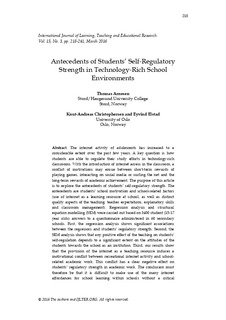| dc.contributor.author | Arnesen, Thomas | |
| dc.contributor.author | Elstad, Eyvind | |
| dc.contributor.author | Christophersen, Knut-Andreas | |
| dc.coverage.spatial | Nordic countries | nb_NO |
| dc.date.accessioned | 2019-04-11T13:26:07Z | |
| dc.date.available | 2019-04-11T13:26:07Z | |
| dc.date.created | 2016-04-28T10:50:26Z | |
| dc.date.issued | 2016 | |
| dc.identifier.citation | Arnesen, T., Elstad, E., & Christophersen, K.-A. (2016). Antecedents of students’ self-regulatory strength in technology-rich school environments. International Journal of Learning, Teaching and Educational Research, 15(3), 218-241. | nb_NO |
| dc.identifier.issn | 1694-2116 | |
| dc.identifier.uri | http://hdl.handle.net/11250/2594306 | |
| dc.description.abstract | The internet activity of adolescents has increased to a considerable extent over the past few years. A key question is how students are able to regulate their study efforts in technology-rich classrooms. With the introduction of internet access in the classroom, a conflict of motivations may ensue between short-term rewards of playing games, interacting on social media or surfing the net and the long-term rewards of academic achievement. The purpose of this article is to explore the antecedents of students’ self-regulatory strength. The antecedents are students’ school motivation and school-related factors (use of internet as a learning resource at school, as well as distinct quality aspects of the teaching: teacher expectations, explanatory skills and classroom management). Regression analysis and structural equation modelling (SEM) were carried out based on 3400 student (15-17 year olds) answers to a questionnaire administered in 60 secondary schools. First, the regression analysis shows significant associations between the regressors and students’ regulatory strength. Second, the SEM analysis shows that any positive effect of the teaching on students’ self-regulation depends to a significant extent on the attitudes of the students towards the school as an institution. Third, our results show that the provision of the internet as a teaching resource induces a motivational conflict between recreational internet activity and school-related academic work. This conflict has a clear negative effect on students’ regulatory strength in academic work. The conclusion must therefore be that it is difficult to make use of the many internet affordances for school learning within schools without a critical awareness of the potential negative side effects on students’ self-regulatory strength. | nb_NO |
| dc.language.iso | eng | nb_NO |
| dc.publisher | Tresorix Ltd. | nb_NO |
| dc.relation.uri | http://ijlter.org/index.php/ijlter/article/view/457/pdf | |
| dc.rights | Attribution-NonCommercial-NoDerivatives 4.0 Internasjonal | * |
| dc.rights.uri | http://creativecommons.org/licenses/by-nc-nd/4.0/deed.no | * |
| dc.subject | ICT and education | nb_NO |
| dc.subject | technology-rich classrooms | nb_NO |
| dc.subject | selfregulation | nb_NO |
| dc.subject | motivational conflict | nb_NO |
| dc.title | Antecedents of students’ self-regulatory strength in technology-rich school environments | nb_NO |
| dc.type | Journal article | nb_NO |
| dc.type | Peer reviewed | nb_NO |
| dc.description.version | publishedVersion | nb_NO |
| dc.rights.holder | © 2016 The authors and IJLTER.ORG. | nb_NO |
| dc.subject.nsi | VDP::Samfunnsvitenskap: 200::Pedagogiske fag: 280 | nb_NO |
| dc.source.pagenumber | 218-241 | nb_NO |
| dc.source.volume | 15 | nb_NO |
| dc.source.journal | International Journal of Learning, Teaching and Educational Research | nb_NO |
| dc.source.issue | 3 | nb_NO |
| dc.identifier.cristin | 1352952 | |
| dc.relation.project | Norges forskningsråd: 218245 | nb_NO |
| cristin.unitcode | 203,6,1,0 | |
| cristin.unitname | Avdeling for lærarutdanning og kulturfag - Stord/Haugesund | |
| cristin.ispublished | true | |
| cristin.fulltext | original | |
| cristin.qualitycode | 1 | |

